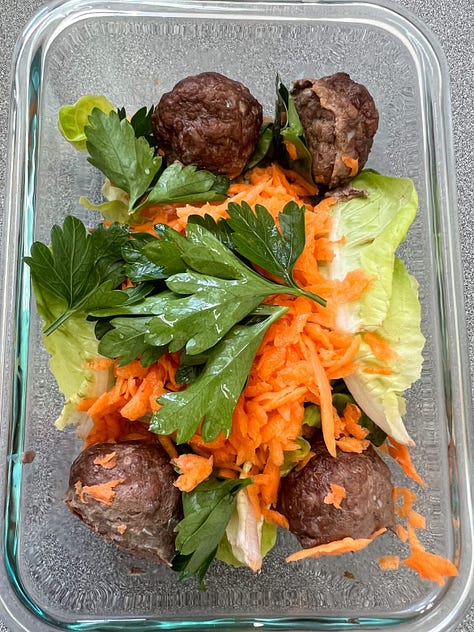the ultimate guide to fasting and reversing pre-diabetes
building insulin sensitivity, short and long-term fasting, meal plans, plus an FAQ!
this post has been reviewed by Michael T. Bollinger, MD
I just wrapped up the most amazing 7-day detox with a group of 60 motivated, kind, and incredibly supportive souls. We've been through quite the journey together!
For many participants, this was their first-ever experience with extended fasting. It's always beautiful to witness that lightbulb moment when people realize their bodies have the natural capacity to fast. The science behind fasting is powerful, but actually experiencing it firsthand? That's what truly motivates and empowers.
What surprises most first-timers is that by day 2, many didn't even feel hungry anymore! This contradicts everything we've been taught about needing to eat every few hours.
Here are some meal photos from participants:









After our detox, our chat was flooded with questions about how to use fasting going forward. People wanted to know…
how to maintain their healthy weight
reduce that stubborn menopause belly fat (I hear you, ladies!)
reverse insulin resistance
tackle pre-diabetes
I wrote this post specifically to answer those questions. Below, I'll share the practical science behind fasting for disease reversal in simple terms, along with a downloadable 7-day meal plan (linked below the paywall) that puts these principles into action in your real life.
Understanding Pre-Diabetes and Type 2 Diabetes
Type 2 diabetes has reached epidemic proportions, affecting millions of people worldwide. According to the CDC, more than 1 in 3 US adults have pre-diabetes (38%) — that's over 96 million Americans. Yet, despite the growing number of medications available to treat this condition, we're missing a fundamental truth: you cannot use drugs to cure a dietary disease.
Some definitions
Pre-diabetes: This is when your blood sugar levels are higher than normal (fasting glucose between 100-125 mg/dL or A1C between 5.7-6.4%), but not yet high enough to be diagnosed as diabetes. It's essentially a warning sign that your body is struggling to process glucose efficiently. Your cells are becoming resistant to insulin (the hormone that helps glucose enter your cells), so your pancreas has to work harder to produce more insulin. At this stage, the condition is often reversible through lifestyle changes, including fasting!
Type 2 diabetes: This develops when your blood sugar levels become chronically elevated (fasting glucose of 126 mg/dL or higher, or A1C of 6.5% or higher) because your body has become significantly resistant to insulin, and/or your pancreas can no longer produce enough insulin to overcome this resistance.
Think of it this way:
Pre-diabetes: Your body's blood sugar management system is stressed but still functioning
Type 2 diabetes: The system can no longer keep up, resulting in chronically high blood sugar that can damage organs and tissues over time
The good news is that pre-diabetes doesn't automatically lead to diabetes. With appropriate changes to diet, exercise, and other lifestyle factors, many people can restore healthier blood sugar levels and prevent progression to diabetes. In fact, many can entirely reverse the condition.
The Root Cause: It's About Sugar
What most people don’t realize is that at its core, type 2 diabetes (and pre-diabetes) is simply too much sugar in the body. Our modern healthcare system often treats this condition by managing symptoms with medications while allowing the underlying problem to persist. But there's a better way.
The solution is remarkably straightforward:
Put less sugar in your body
Burn off the remaining excess sugar
This approach is natural, free, and requires no surgery and no drugs. Let's break it down further.
The Food Factor: What To Eat (And Not Eat)
The diet that reverses pre-diabetes and type 2 diabetes looks quite different from the standard American diet. It requires:
Eliminating sugar and refined carbohydrates - (White bread, pasta, rice) These foods directly contribute to elevated blood glucose levels and insulin resistance
Moderating protein intake - While protein is essential, excessive amounts are unnecessary. More than 50 grams of protein per meal is excessive as your body cannot utilize more than that. To figure out your perfect protein amount, use this calculator.
Embracing healthy dietary fats - Contrary to outdated beliefs, healthy fats have minimal effects on blood glucose and help you feel satiated.
Not fearing dietary cholesterol - Research shows that dietary cholesterol has no harmful effect on the human body and actually helps you feel full without adding sugar to your system.
If you need help with a meal plan, scroll to the bottom to download my 7-day meal plan for reversing pre-diabetes.
*If you are on insulin, all of these suggestions apply, but please check with your doctor to help you manage the optimal dose as you make dietary changes and implement fasting. Medication adjustments are typically necessary as your insulin sensitivity improves.
Why Portion Control Fails
Many people with type 2 diabetes and pre-diabetes are advised to practice portion control and calorie restriction. However, this approach typically fails because:
Restricting calories causes a rebound increase in hunger
It decreases the body's metabolic rate (putting you in "starvation mode")
It doesn't address the fundamental hormonal imbalance causing diabetes
The problem with diabetes isn't about calories – it's about hormones, specifically insulin.
The Insulin Factor
Insulin is a critical hormone that regulates blood sugar. In type 2 diabetes, and even before that, pre-diabetes, the body becomes resistant to insulin's effects, requiring more and more insulin to control blood sugar. This creates a vicious cycle:
High carb/sugar intake → Elevated blood glucose → More insulin needed
Chronically high insulin → Insulin resistance → Even more insulin needed
Eventually → Pancreas can't keep up → Type 2 diabetes develops
The irony is that treating type 2 diabetes with insulin can actually worsen the underlying insulin resistance. As
often says, "Giving insulin when someone already has too much insulin doesn't make sense."The Power of Intermittent Fasting
This is where intermittent fasting comes in as a powerful intervention. Unlike chronic caloric restriction, intermittent fasting:
Produces beneficial hormonal changes
Significantly reduces insulin and insulin resistance
Creates extended periods of low insulin that maintain the body's sensitivity to insulin
Allows the body to burn through excess glucose
Fasting works because it addresses the root cause: too much sugar in the body. When we fast, our body:
First burns through glycogen stored in the liver
Then begins burning body fat for fuel
Maintains or even increases basal metabolic rate (unlike calorie restriction)
Reversing Pre-Diabetes in 8-12 weeks
If you’ve gotten this far, your interest in this subject likely stems from getting diagnosed with either fatty liver disease, pre-diabetes, or type 2 diabetes, and you’re thinking, “now what?”
The approach below is a practical, 8-12 week protocol to reverse pre-diabetes and type 2 diabetes and become metabolically flexible again. It’s science-backed and doctor approved, plus there’s a bunch of resources and support waiting for you at the bottom.
1. Dietary Changes
Eliminate sugar and refined carbohydrates
Remove obvious sugars (candy, soda, desserts)
Cut out refined grains (white bread, pasta, rice)
Beware of hidden sugars in sauces, dressings, and "health foods"
Focus on whole foods
Abundant non-starchy vegetables
Quality proteins (grass-fed, pasture-raised when possible)
Healthy fats (avocados, extra virgin olive oil, nuts, seeds)
Don't fear healthy fat
It helps control hunger without raising blood sugar
Provides essential nutrients
Supports hormone production
2. Incorporate Fasting
Begin with intermittent (16-hour overnight) fasts
Finish dinner by 6 pm
Eat nothing until 10 am the next day
Do this 5-7 days per week
Gradually work up to 24-30 hour fasts
Start with one longer fast per week
Example: Eat dinner as usual on Sunday night, then fast all day Monday (supported with allowed liquids), then eat a healthy meal prioritizing protein, healthy fat, and fiber Monday night (or Tuesday morning for a 30-hour fast)
During fasts, consume only:
Water (plain or sparkling)
Bone broth 8 ounces, up to 4 times daily
No-sugar electrolytes
Filtered water with sea salt and lemon
Herbal tea, green tea, or black coffee
Optional: 1 scoop clean protein shake at strategic intervals (8am, 11:30am, 3pm, 6:30pm) to preserve muscle during longer fasts
3. Include Regular Exercise
Strength/resistance training 2-3 times per week
Preserves and builds muscle mass
Improves insulin sensitivity
Supports metabolic health
Zone 2 cardio 2-3 times per week
Moderate intensity where you can still hold a conversation
Improves metabolic flexibility
During fasting, listen to your body’s energy
I can weight train while I’m fasting, but if you’re new to fasting, you may want to opt for gentle yoga or walking on those days
4. Slow Reintroduction
After 8-12 weeks of following steps 1-3, you will have gone through a time of intense metabolic healing
Once you’re metabolically stable, you can slowly start reincorporating small portions of foods like whole grains, complex carbs, fruit, and low-sugar desserts
You can also stop doing longer fasts every week, although intermittent fasting can still be part of your routine, but it can become a more flexible 12-16 hour nightly fast
This combination gives your body a chance to use up circulating sugar, heal fatty liver disease, and bring insulin levels and blood sugar into a normal range – and it's free!
Next Steps for Your Health Journey
Beyond Blood Sugar: The Bigger Picture
Reversing pre-diabetes and type 2 diabetes isn't just about normalizing blood sugar readings. It's about addressing the underlying hormonal imbalances that caused the problem in the first place.
By addressing this root cause, not only can diabetes be reversed, but sustainable weight management becomes possible, too.
Join Our Community
July 14-21 Detox Program: If you'd like to experience the benefits of our structured 7-day detox program, I'm hosting another group detox in July! Read all about the process (plus testimonials) here.
Disclaimer: This article is for informational purposes only and is not intended as medical advice. Always consult with a qualified healthcare provider before making significant changes to your diet or exercise routine, particularly if you have existing health conditions or take medications.
2 Premium Resources for Paid Subscribers
1. Exclusive Download: 7-Day Meal Plan for Reversing Pre-Diabetes
This meal plan demonstrates how to implement the principles for reversing pre-diabetes through a low-carb, healthy-fat approach combined with intermittent fasting. The plan includes three different fasting schedules to choose from based on your experience level and preferences.
2. Frequently Asked Questions
For answers to the most common questions about fasting, metabolism, and blood sugar.
Keep reading with a 7-day free trial
Subscribe to Nest Wellness by Beth Bollinger to keep reading this post and get 7 days of free access to the full post archives.









